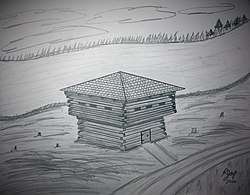Fort Hanson
Fort Hanson was a blockhouse fortification built in 1838 by the United States Army as one of a chain of military outposts created during the Second Seminole War. These fortifications were located near vital road and waterway routes, or were built within a day’s journey of one another. Fort Hanson was primarily built for the protection of the St. Augustine area in the Florida Territory. St. Augustine had become refuge for many white settlers and their slaves that had fled from nearby settlements and plantations for safety in the city. In addition to St. Augustine being an important shipping port and supply center for the war effort the additional civilians made the city a key stronghold requiring a substantial military presence for its defense. The fort originally stood about thirteen miles southwest of St. Augustine.[1][2]
| Fort Hanson | |
|---|---|
| Fort Hanson was located approx. 13 Miles Southwest of St. Augustine, Florida. in United States | |
 Fort Hanson - Second Seminole War Fort (artist's depiction). | |
 Fort Hanson Location of Fort Hanson  Fort Hanson Fort Hanson (the United States) | |
| Coordinates | 29°49′29″N 81°21′36″W |
| Site information | |
| Condition | Completely destroyed. |
| Site history | |
| Built | 1838 |
| Built by | United States Army |
| In use | 1838-1840 |
| Materials | Pine log blockhouse |
| Fate | Abandoned in 1840 and burnt to the ground by the Seminole Indians and their allies. |
| Battles/wars | None recorded. |
| Events | Defense of St. Augustine during the Second Seminole War. |
| Garrison information | |
| Past commanders | R.H.K. Whitley, 1st Lt. |
| Garrison | Regular army troops. |
Brief History
Fort Hanson was established in 1838 by R.H.K. Whitley, 1st Lt., and was garrisoned by regular U.S. Army troops. It was also tasked with providing reconnaissance and communications to warn U.S. Army troops stationed in St. Augustine of any Seminole Indian activity in its general vicinity. After only two years of service Fort Hanson was ordered abandoned on May 13, 1840 by the United States Secretary of War Joel Roberts Poinsett (1779-1851). Poinstett sent a correspondence to General Walker Keith Armistead (1773–1845), commander of the U.S. Army from 1840-1841, with orders to abandon two St. Augustine area forts: Fort Hanson and Fort Peyton. Three new forts were being planned as their replacements. Only one fort, Fort Fulton, (which was in active service prior to Poinsett's letter) actually served as a replacement for Fort Hanson and Fort Peyton. The other two replacement forts were never established. Fort Hanson was abandoned in 1840 and later burned to the ground by the Seminoles, and Fort Peyton was abandoned in May 1840 and burned to the ground on February 14, 1842. No known attacks or skirmishes were recorded at Fort Hanson during the Second Seminole War.[1][3]
Fort Hanson’s Namesake: Weightman Kay Hanson
Weightman Kay Hanson was born on July 25, 1816 in Washington City, District of Columbia. He was a U.S. Army cadet at the United States Military Academy in West Point, New York and graduated on July 1, 1835. He served frontier duty in the 7th Infantry in Oklahoma from July 1835 to the end of 1838. He was a Brevet Second Lieutenant at Fort Coffee, and was promoted to Second Lieutenant on June 8, 1836, and then first lieutenant on July 7, 1838 while serving at Fort Gibson. He was deployed to the Florida Territory in 1839 during the Second Seminole War.[4] In 1839, while commanding Fort Mellon he captured fifty-one Seminole Indians and escorted the prisoners to Charleston, South Carolina.[5] On August 3, 1839, the citizens of St. Augustine awarded him a gold sword for Meritorious Conduct and Gallantry in the Florida War. He was then promoted to Brevet Captain. On September 6, 1840 he commanded U.S. troops in a skirmish near Wacahoota, Florida. [4]
He returned to the United States Military Academy as an Assistant Professor of Mathematics and taught from November 15, 1841 until his death on July 22, 1844.[4]
Site of Fort Hanson
Today, the actual site of Fort Hanson is unmarked. Its approximate location is known from historical records and maps, but no professional archaeological survey has been conducted to pinpoint its original location.[6]
References
- Jaye, Randy. Second Seminole War (1835-1842) Fortifications in the Present-day Volusia and Flagler County Area. Halifax Herald, Volume 35, Number 2, Fall 2017.
- Waterbury, Jean Parker (editor). The Oldest City – St. Augustine Saga of Survival (1983). St. Augustine Historical Society. pp. 164-171.
- Andrews, Mark. Forts Played Role in Florida History. Orlando Sentinel. August 11, 1991. pp. K1, K4.
- Cullum, George W. Biographical Register of the Officers and Graduates of the United States Military Academy. Class of 1835. #807.
- Mahon, John K. History of the Second Seminole War (1967). Gainesville, FL: University of Florida Press. p. 263.
- Word, Ron. Historic Osceola sites vanishing. The Tampa Tribune. May 11, 2001, p. 31.